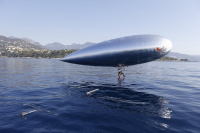








A Zeppelin is a type of rigid airship named after the German Count Ferdinand von Zeppelin who pioneered rigid airship development at the beginning of the 20th century. Zeppelin's ideas were first formulated in 1874 and developed in detail in 1893. They were patented in Germany in 1895 and in the United States in 1899.After the outstanding success of the Zeppelin design, the word zeppelin came to be commonly used to refer to all rigid airships. Zeppelins were first flown commercially in 1910 by Deutsche Luftschiffahrts-AG (DELAG), the world's first airline in revenue service. By mid-1914, DELAG had carried over 10,000 fare-paying passengers on over 1,500 flights. During World War I the German military made extensive use of Zeppelins as bombers and scouts, killing over 500 people in bombing raids in Britain.
Ferdinand, Graf von Zeppelin, in full Ferdinand Adolf August Heinrich, Graf von Zeppelin (born July 8, 1838, Konstanz, Baden—died March 8, 1917, Charlottenburg, near Berlin), first notable builder of rigid dirigible airships, for which his surname is still a popular generic term.
Zeppelin received a military commission in 1858. He made the first of several balloon ascensions at St. Paul, Minnesota, while acting as a military observer (1863) for the Union Army during the American Civil War. He saw military action in 1866 during the Seven Weeks’ War and in 1870–71 during the Franco-German War, serving successively in the armies of Württemberg, Prussia, and imperial Germany. He retired in 1890 and devoted the rest of his life to the creation of the rigid airship for which he is known.
Zeppelin struggled for 10 years to produce his lighter-than-air craft. The initial flight (July 2, 1900) of the LZ-1 from a floating hangar on Lake Constance, near Friedrichshafen, Germany, was not entirely successful, but it had the effect of promoting the airship to the degree that public subscriptions and donations thereafter funded the count’s work. The German government was quick to perceive the advantage of airships over the as yet poorly developed airplanes, and when Zeppelin achieved 24-hour flight in 1906, he received commissions for an entire fleet. More than 100 zeppelins were used for military operations in World War I. A passenger service known as Delag (Deutsche-Luftschiffahrts AG) was established in 1910, but Zeppelin died before attaining his goal of transcontinental flight.